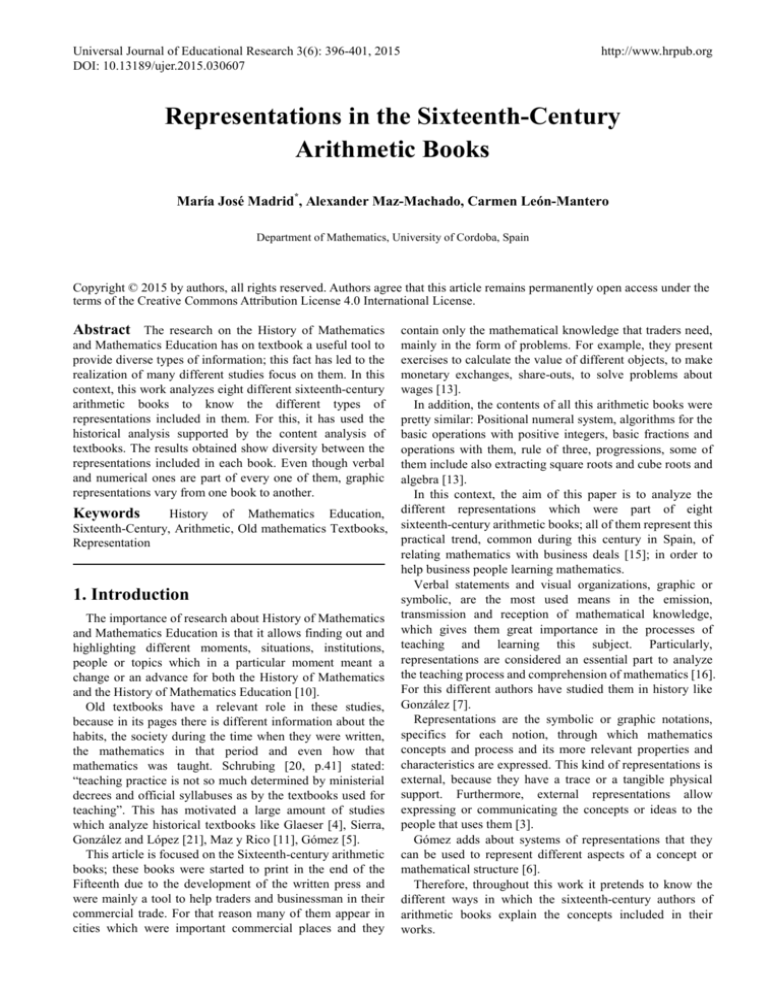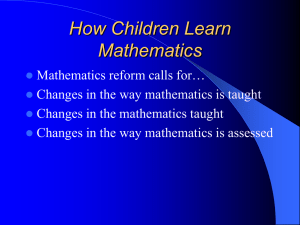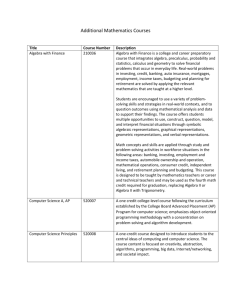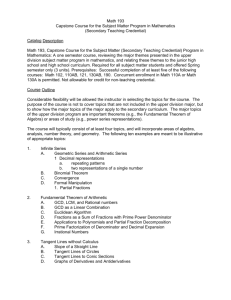
Universal Journal of Educational Research 3(6): 396-401, 2015
DOI: 10.13189/ujer.2015.030607
http://www.hrpub.org
Representations in the Sixteenth-Century
Arithmetic Books
María José Madrid*, Alexander Maz-Machado, Carmen León-Mantero
Department of Mathematics, University of Cordoba, Spain
Copyright © 2015 by authors, all rights reserved. Authors agree that this article remains permanently open access under the
terms of the Creative Commons Attribution License 4.0 International License.
Abstract The research on the History of Mathematics
and Mathematics Education has on textbook a useful tool to
provide diverse types of information; this fact has led to the
realization of many different studies focus on them. In this
context, this work analyzes eight different sixteenth-century
arithmetic books to know the different types of
representations included in them. For this, it has used the
historical analysis supported by the content analysis of
textbooks. The results obtained show diversity between the
representations included in each book. Even though verbal
and numerical ones are part of every one of them, graphic
representations vary from one book to another.
Keywords
History of Mathematics Education,
Sixteenth-Century, Arithmetic, Old mathematics Textbooks,
Representation
1. Introduction
The importance of research about History of Mathematics
and Mathematics Education is that it allows finding out and
highlighting different moments, situations, institutions,
people or topics which in a particular moment meant a
change or an advance for both the History of Mathematics
and the History of Mathematics Education [10].
Old textbooks have a relevant role in these studies,
because in its pages there is different information about the
habits, the society during the time when they were written,
the mathematics in that period and even how that
mathematics was taught. Schrubing [20, p.41] stated:
“teaching practice is not so much determined by ministerial
decrees and official syllabuses as by the textbooks used for
teaching”. This has motivated a large amount of studies
which analyze historical textbooks like Glaeser [4], Sierra,
González and López [21], Maz y Rico [11], Gómez [5].
This article is focused on the Sixteenth-century arithmetic
books; these books were started to print in the end of the
Fifteenth due to the development of the written press and
were mainly a tool to help traders and businessman in their
commercial trade. For that reason many of them appear in
cities which were important commercial places and they
contain only the mathematical knowledge that traders need,
mainly in the form of problems. For example, they present
exercises to calculate the value of different objects, to make
monetary exchanges, share-outs, to solve problems about
wages [13].
In addition, the contents of all this arithmetic books were
pretty similar: Positional numeral system, algorithms for the
basic operations with positive integers, basic fractions and
operations with them, rule of three, progressions, some of
them include also extracting square roots and cube roots and
algebra [13].
In this context, the aim of this paper is to analyze the
different representations which were part of eight
sixteenth-century arithmetic books; all of them represent this
practical trend, common during this century in Spain, of
relating mathematics with business deals [15]; in order to
help business people learning mathematics.
Verbal statements and visual organizations, graphic or
symbolic, are the most used means in the emission,
transmission and reception of mathematical knowledge,
which gives them great importance in the processes of
teaching and learning this subject. Particularly,
representations are considered an essential part to analyze
the teaching process and comprehension of mathematics [16].
For this different authors have studied them in history like
González [7].
Representations are the symbolic or graphic notations,
specifics for each notion, through which mathematics
concepts and process and its more relevant properties and
characteristics are expressed. This kind of representations is
external, because they have a trace or a tangible physical
support. Furthermore, external representations allow
expressing or communicating the concepts or ideas to the
people that uses them [3].
Gómez adds about systems of representations that they
can be used to represent different aspects of a concept or
mathematical structure [6].
Therefore, throughout this work it pretends to know the
different ways in which the sixteenth-century authors of
arithmetic books explain the concepts included in their
works.
Universal Journal of Educational Research 3(6): 396-401, 2015
397
2. Methodology
This research is exploratory and descriptive which
historical-mathematical nature.
We have used primary sources and selected eight books,
all of them written in Spanish and published during the
sixteenth-century. These books had a large influence during
this century and the followings; they were used to learn
mathematics at universities, houses of trade, etc. Indeed,
many of them had versions which were printed even in the
XVIII-century.
The chosen books are: Conpusicion de la arte de la
arismetica y Juntamente de geometría written by Juan de
Ortega in 1512 [12], Sumario breve de la practica de
arithmetica de todo el curso del arte mercantivol written by
Juan Andres in 1515 [1], Arithmetica Practica written by
Juan de Yciar in 1549 [23], Suma de Arihtmetica Practica y
de todas Mercaderias con la horden de contadores written
by Gaspar de Texeda in 1546 [22] , Libro primero de
Arithmetica Algebratica written by Marco Aurel in 1552 [2],
Arte breve y muy provechoso de cuenta castellana y
Arismetica written by Juan Gutierrez de Gualda in 1564 [8],
Arithmetica written by Antich Rocha in 1564 [17] and
Libro de arithmetica especvlativa, y práctica, intitvlado, el
Dorado Contador written by Miguel Geronimo de Santa
Cruz [19] (its first edition was published in 1594, but the
one used in this work was printed in1625).
The methodology used to examine these books is the
historical analysis supported by the content analysis of
textbooks. All the paragraphs from the books have been
considered analysis units, which have been read,
categorized and finally analyzed.
Figure 1. Verbal representation from Juan Andres’ book (Page LVI).
•
Numerical
representation:
This
kind
of
representations is combined in general with verbal
representations. The authors used numbers, lines and
symbols to present different operations, exercises,
examples... Figure 2 shows an example of numerical
representation.
Figure 2. Numerical representation in Ortega’s book (Page 48).
•
Graphical representation: These representations
include tables, figures, geometric representations,
diagrams and mixed representations.
Tables and diagrams are used to present assembled
information which helps readers to understand the different
contents. For example, in Figure 3 and 4 there are two
examples of different multiplication tables included in the
books.
3. Results
As it was stated before, representations in this work mean
the signs, notations, figures or expressions through which
mathematics are expressed [3]. In these books three general
types of representation can be found, the classification made
is based on the one suggested by Maz-Machado, López y
Sierra [9]:
•
Verbal representation: It is the main type of
representation in the books. Most concepts, methods
and properties are explained using words; for
example, in Figure 1 is shown a verbal
representation.
Figure 3. Multiplication table in Rocha’s book (Page 28).
398
Representations in the Sixteenth-Century Arithmetic Books
Figure 4. Multiplication table in Marco Aurel’s book (Page 5).
Figures are used to illustrate the contents of the books, mainly geometric ones, like Figures 5 and 6.
Figure 5. Figures from both Yciar’s book (Page XLIIII) and Gutierrez.
Figure 6. Figures from Texeda’s book (Page XLIIII).
They use geometric graphics, which are, in general, basic polygons, to explain concepts which relate to square roots, like in
Figure 7.
Universal Journal of Educational Research 3(6): 396-401, 2015
399
Figure 7. Triangles (Page 194) and a hexagon (Page 202) from Ortega’s book.
In mixed graphics, it presents numbers, words, lines or brackets combined, like in Figure 8.
Figure 8. A mixed representation from Miguel Geronimo de Santa Cruz’s book (Page 163).
To sum up, the following table (1) shows the different types of representations included in the books.
Table 1. Representations in the Sixteenth-Century books
REPRESENTATIONS
AUTHORS
Verbal
Numerical
Juan de Ortega
X
Graphics
Tables
Geometric
X
X
X
Figures
Diagrams
Mixed
X
Juan Andrés
X
X
X
X
X
X
Juan de Yciar
X
X
X
X
X
X
Gaspar de Texada
X
X
X
X
X
X
Marco Aurel
X
X
X
Juan Gutiérrez
X
X
X
Antich Rocha
X
X
X
X
X
Miguel Gerónimo de
Santa Cruz
X
X
X
X
X
X
X
400
Representations in the Sixteenth-Century Arithmetic Books
This table shows the supremacy of verbal and numerical
representations; they are not only part of every book, but also
the main types of representation in them. However, the
analysis of graphic representations shows more diversity,
because apart from tables, none of the other types of graphic
representations can be found in all the books.
Diagrams and figures are the less present in the books.
Only one diagram can be found in Santa Cruz and Rocha’s
books and apart from Juan de Yciar, Gaspar de Texeda and
Juan Gutierrez who include several figures in their books,
Juan Andres include only two pages with figures.
Futhermore, opposite to Juan de Yciar, Gaspar de Texeda
or Juan Gutierrez who include figures to help understanding
geometric problems, Juan Andres include in its two pages a
serie of hands which represents different numbers. Picatoste
[14] states these sheets reffer to the dactylology or art of
finger-counting.
were well-known during the sixteenth-century and even in
the following centuries. These books play a key role helping
business man, traders, etc. learning basic mathematics
which were necessary to improve their business, avoid
deceptions, etc. in a time in which the commerce started
to grow. These reasons have motivated the realization of
this study about representations in the different books.
In addition, representations are used to communicate the
different mathematical concepts; during this study it has
been found out that representations were not too similar in
the books. Verbal and numerical are the main type of
representation in all of them, the authors use them to
express most concepts and examples.
Along with these two types in the books there are graphic
representations, but apart from tables no other graphic
representations appear in all the books. The different
authors showed different ways of explaining similar
contents, for example, authors like Juan de Yciar or Gaspar
de Texeda used figures to help understand geometric
problems, Miguel Geronimo de Santa Cruz and Antich
Rocha include diagrams to sum up the contents.
Some of the possible next steps in this research will be
studying the mathematical contents of the books, comparing
them to know the main differences and similarities between
them, to see how they influence each other, etc.
Acknowledgements
Figure 9. Figure in Juan Andres’book.
Another remarkable fact is that all figures which appear in
Juan Gutiérrez’ book appear also in Juan de Yciar’s one.
This may be because this edition of Juan Gutierrez’ book
appeared joined to one of Juan de Yciar’s calligraphy which
was also published in 1564, so it is possibble that he copied
the figures from Juan de Yciar’s arithmetic book, which was
published in 1549, but Gutierrez wrote other arithmetic
books previously [14, 18] and in fact before Yciar’s
arithmetic book and we don’t know if those previous editions
contain these figures. Another possibility could be that these
figures were part of the same printing press, because both
books from Yciar [23] and Gutierrez [8] were printed in
Zaragoza and in Pedro Bernuz’ house, so maybe they just
reused the figures they had already printed.
Finally, Marco Aurel and Juan Gutierrez are the ones
who present a smaller number of graphical representations;
indeed in Aurel’s book only tables can be found, and in
Gutiérrez’s book only tables and figures. On the other hand,
Juan de Yciar, Gaspar de Texeda, Miguel Geronimo de
Santa Cruz and Juan Andres show six of the seven different
categories considered.
4. Conclusions
Several arithmetic books written with mercantile aim
This work has been realized inside the research project of
the R+D+i Plan for the Ministry of Economy and
Competitiveness of Spain EDU2011-27168.
REFERENCES
[1]
J. Andres. Sumario breve de la practica de la arithmetica,
Juan Joffre, Valencia, 1515.
[2]
M. Aurel. Libro Primero de Arithmetica Algebratica, casa de
Ioan de Mey Flandro, Valencia, 1552.
[3]
E. Castro, E. Castro. Representaciones y modelización. En
Rico, L. (coord.), La educación matemática en la enseñanza
secundaria, 95-124, Horsori, Barcelona, 1997.
[4]
G. Glaeser. Epistémologie des nombres relatifs, Recherches
en Didactique des Mathématiques, Vol.2, No.39, 303-346,
1981.
[5]
B. Gómez. El análisis de manuales y la identificación de
problemas de investigación en Didáctica de las Matemáticas,
PNA, Vol.5, No.2, 49-65, 2011.
[6]
P. Gómez. Análisis didáctico y diseño curricular en
matemáticas, Revista EMA, Vol.7, No.3, 251-292, 2002.
[7]
M.T. González. Sistemas de representación en la enseñanza
de los puntos críticos: perspectiva histórica, Revista Dialogo
Educacional, Vol.6, No.8, 145-160, 2006.
Universal Journal of Educational Research 3(6): 396-401, 2015
[8]
J. Gutierrez. Arte Breve y muy provechoso de quenta
castellana y Arithmetica, casa de Pedro Bernuz, Zaragoza,
1564.
[9]
A. Maz-Machado, C. López, M. Sierra. Fenomenología y
representaciones en la Arithmetica de Juan de Yciar. En L.
Rico L., Cañadas, M. C., Gutiérrez, J., Molina, M. y Segovia,
I. (Eds.), Investigación en Didáctica de las Matemática.
Homenaje a Encarnación Castro, pp. 77-84, Editorial
Comares, Granada, 2013.
[10] A. Maz-Machado, L. Rico. Tratado elemental de
matemáticas, de José Mariano Vallejo, en el bicentenario de
su publicación, Suma, Vol.74, 55-63, 2013.
[11] A. Maz, L. Rico. Negative numbers in the 18th and 19th
centuries: phenomenology and representations, Electronic
Journal of Research in Educational Psychology, Vo1.7, No.1,
537-554, 2009.
[12] J. de Ortega. Conpusicion de la arte de la arismetica y
Juntamente de geometría, casa de Maistro Nicolau de
Benedictis, León, 1512.
[13] J. Paradís, A. Malet. La génesis del álgebra simbólica. (Vol.
I). Los orígenes del álgebra: De los árabes al Renacimiento,
PPU, Barcelona, 1989.
[14] F. Picatoste. Apuntes para una biblioteca científica española
del siglo XVI; estudios biográficos y bibliográficos de
ciencias exactas físicas y naturales y sus inmediatas
aplicaciones en dicho siglo, Manuel Tello, Madrid, 1891.
Online available from
http://bibliotecadigital.jcyl.es/i18n/consulta/registro.cmd?id=
13965
401
[15] J. Rey Pastor. Los matemáticos españoles del siglo XVI,
Biblioteca Scientia, 2, 1926.
[16] L. Rico. Sobre las nociones de representación y comprensión
en la investigación en educación matemática, PNA, Vol. 4,
No.1, 1-14, 2009.
[17] A. Rocha. Arithmetica, casa de Claudio Bornat a la Águila
Fuerte, Barcelona, 1564.
[18] V. Salavert. Introducción a la historia de la aritmética
práctica en la Corona de Aragón en el siglo XVI, DYNAMIS,
Vol.10, 63-911, 1990.
[19] M.G. de Santa Cruz. Libro de arithmetica especvlativa, y
práctica, intitvlado, el Dorado Contador, contiene la fineza y
reglas de contar oro y plata, y los Aneajes de Flandes, Viuda
de Alonso Martín, Madrid, 1625.
[20] G. Schubring. On the methodology of analysing historical
textbooks: Lacroix as textbook authors, For the learning of
mathematics, Vol.7, No.3, 41-51, 1987.
[21] M. Sierra, M.T. González, C. López. El concepto de
continuidad en los manuales españoles de enseñanza
secundaria de la segunda mitad del siglo XX, Educación
Matemática, Vol. 15, No.1, 21-49, 2003.
[22] G. de Texeda. Suma de Arihtmetica Practica y de todas
Mercaderias con la horden de contadores, Oficina de
Francisco Fernández de Córdoba, Valladolid, 1546.
[23] J. de Yciar. Arithmetica Practica, casa de Pedro Bernuz,
Zaragoza, 1549.







